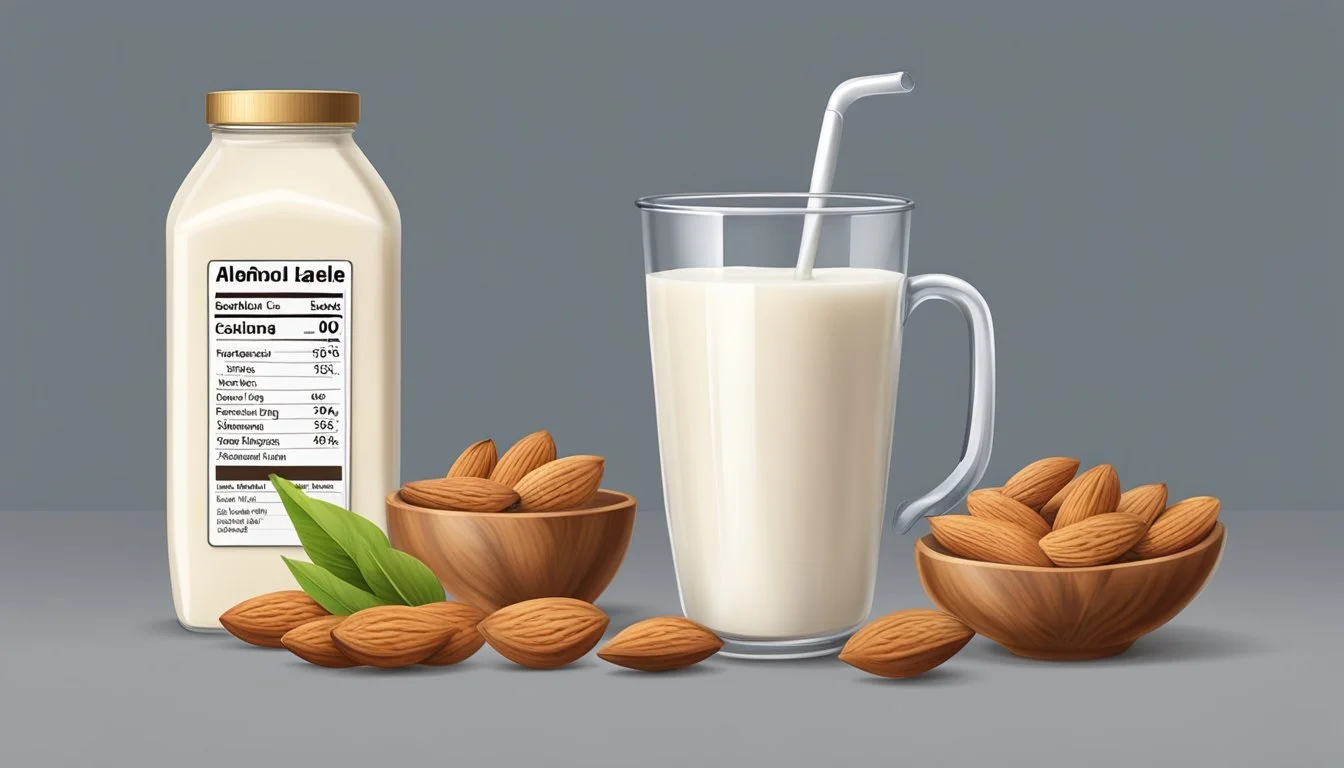How Many Cups of Almond Milk per Day Is Too Much?
Understanding Limits for Health
Almond milk is a popular dairy alternative that offers a low-calorie option for those looking to manage their weight or for those who avoid dairy due to allergies or dietary preferences. With only around 37 to 39 calories per cup for unsweetened varieties, it can be an attractive substitute for higher-calorie milks. As consumers integrate almond milk into their diets, a common question arises: how much almond milk is too much in a day?
Nutritional balance is key in any diet, and the consumption of almond milk is no exception. While almond milk provides beneficial nutrients such as vitamin E and is often enriched with calcium and vitamin D, it's important to consider the potential for overconsumption. Excessive intake of any single food can result in a nutritional imbalance, potentially leading to an excessive intake of certain nutrients or additives found in commercial almond milk products. Additionally, sweetened almond milk varieties contain added sugars, which can increase calorie intake and possibly undermine weight management efforts if consumed in large quantities.
It is essential to examine both the nutritional content of almond milk and the context of an individual's overall dietary pattern to determine an appropriate amount. Almond milk can be a healthy addition to most diets when consumed in moderation, keeping in mind that dietary needs vary from person to person. Consulting with a nutritionist or healthcare provider can offer personalized guidance tailored to individual health goals and nutritional requirements.
Nutritional Profile of Almond Milk
Almond milk, as a dairy alternative, presents a unique nutritional composition. Whether unsweetened or sweetened, its macro and micronutrient profile directly influences its standing as a healthy beverage option.
Macro and Micronutrients
One cup of unsweetened almond milk typically contains approximately:
Calories: 39
Protein: 1g
Fat: 2.5g
Carbohydrates: 3.4g
Fiber: 1g
Sugars: 0g (no added sugar)
In addition to these macronutrients, almond milk is fortified with various vitamins and minerals:
Calcium: Often comparable to cow's milk; varies by brand
Vitamin D: Frequently added to fortify the milk
Vitamin E: Natural content is high due to almonds
Comparison with Other Milk Varieties
When comparing unsweetened almond milk to dairy and other plant-based milks (assuming fortified versions):
Nutrient Almond Milk Cow's Milk Soy Milk Oat Milk Calories Low Higher Moderate Moderate Protein Low High High Low Fat Low Varies Moderate High Carbohydrates Low Moderate Low High Calcium Fortified Natural Fortified Fortified Vitamin D Fortified Fortified Fortified Fortified
Almond milk is considerably lower in calories and protein compared to cow's milk and soy milk. However, it also contains less natural sugar, making it a suitable option for those managing sugar intake and those with lactose intolerance.
Added Ingredients in Commercial Almond Milk
Commercial almond milk often includes additional components to enhance flavor, texture, and nutritional value. Key additives to look out for include:
Sweeteners: Sweetened versions can contain up to 10 grams of added sugar per cup.
Thickeners and Emulsifiers: They improve stability and texture.
Preservatives: Extend shelf life.
Flavorings: Such as vanilla or chocolate, contributing to sugar content.
Choosing unsweetened almond milk can help limit intake of added sugars, while selecting fortified versions can enhance vitamin and mineral consumption.
Health Benefits and Concerns
Consuming almond milk offers various health advantages due to its nutrient composition, but overconsumption may raise concerns. It is essential to consider its impact on cardiovascular and bone health, weight management, blood sugar levels, digestive health, and potential allergies or intolerances.
Cardiovascular Health
Almond milk is low in saturated fat and high in unsaturated fats, which can help maintain healthy cholesterol levels, potentially reducing the risk of heart disease. Its content of antioxidants also helps to combat free radicals, known to contribute to heart disease.
Bone Health
Fortified almond milk is a good source of both calcium and vitamin D, nutrients essential for bone health. However, unfortified almond milk naturally contains lower amounts of these nutrients compared to cow's milk, so choosing fortified products is key for maintaining strong bones.
Weight Management
Almond milk is low in calories, with just 30 to 50 calories per cup for unsweetened varieties, making it beneficial for weight management. Its low caloric content, paired with being a lower-fat option, can support a calorie-controlled diet.
Diabetes and Blood Sugar Control
Unsweetened almond milk has a low glycemic index and is low in carbohydrates, which may aid in blood sugar control, making it a suitable option for individuals with diabetes. It also lacks added sugars that spike blood glucose levels.
Digestive Health
Almond milk contains dietary fiber, albeit in small amounts. Fiber can be beneficial for digestive health by preventing constipation and promoting regularity. For some individuals, it can also be easier to digest than cow's milk due to the absence of lactose.
Allergies and Intolerances
Almond milk is lactose-free and suitable for vegans and individuals with a dairy allergy. However, it is not suitable for those with nut allergies, as almonds are tree nuts, and it could trigger an allergic reaction.
Dietary Considerations
When it comes to including almond milk in one's diet, it is essential to consider its nutritional profile, suitability for various dietary needs, portion size, and the presence of additives. Almond milk can be a versatile and nutritious addition when consumed in appropriate quantities.
Incorporating Almond Milk in a Balanced Diet
Almond milk is often low in calories, especially in its unsweetened varieties, making it a favored option for individuals monitoring their caloric intake. Nutrients such as vitamin E are prevalent in almond milk, which can contribute to a balanced diet. Almond milk can be used in recipes ranging from cereal and smoothies to sauces and baking applications. However, since it's lower in protein compared to cow's milk, individuals should ensure they are receiving adequate protein from other dietary sources.
Suitability for Various Diets
Almond milk is especially suitable for vegan and plant-based diets, as well as for those who are dairy-free. Its plant-based milk characteristics allow for a dairy alternative without sacrificing taste or texture in many culinary uses. Almond milk's versatility lends itself well to a variety of recipes, helping those with dietary restrictions maintain a diverse and enjoyable diet.
Portion Control and Consumption Recommendations
When considering the daily intake of almond milk, it is crucial to focus on serving size. As with any food, moderation is key. For almond milk, a common serving size is one cup (240 ml), but individual needs may vary based on overall diet and health objectives. Nutritional experts often suggest that one to two servings per day can fit into a balanced diet without overconsumption of certain nutrients.
Concerns Over Additives and Preservatives
Some almond milk brands include additives such as carrageenan, gums, emulsifiers, and flavors, which can be a concern for some consumers. Preservatives prolong shelf life but can be undesirable for those seeking a more natural diet. Checking labels for unsweetened varieties without unwanted additives or reading about the brand's production practices can help in making informed choices.
Environmental and Ethical Considerations
When considering the environmental and ethical impact of almond milk consumption, it is important to recognize its standing as a popular dairy alternative among those following vegan diets or seeking plant-based milks. Almond milk's rise in popularity is partly due to its perceived sustainability compared to dairy milk, as well as its alignment with ethical diets that exclude animal products.
Water Usage
Almond milk production does require a significant amount of water. Estimates suggest that approximately 84 gallons of water are needed to produce the almonds used in a typical store-bought gallon of almond milk. However, this is less water-intensive than cow's milk on a per-cup comparison, making almond milk a preferable option for environmentally-conscious consumers.
Environmental Impact
The carbon footprint generated by almond milk production is also a point of consideration. Almond milk generally creates lower levels of carbon emissions pre-shipping compared to dairy milk. Unsweetened versions of almond milk offer fewer calories and almost no saturated fats, contributing to their ethical appeal. But there is a trade-off with any agricultural product, and it is true that extensive almond plantations can lead to other environmental concerns, such as bee population impacts due to the high demand for pollination services.
Nutrient Use Efficiency
Comparative to other nut milks, almond milk production might be less efficient in terms of water and nutrient use. For example, peanuts require considerably less water to grow than almonds, suggesting that other plant-based milks might have lower environmental footprints.
Consumers should weigh these environmental and ethical considerations when deciding on the appropriate quantity of almond milk to incorporate into their diets, as well as when comparing it to other milk substitutes. Moderation is key, as with any food product, to ensure a more sustainable dietary pattern.
Choosing and Using Almond Milk
Selecting the right almond milk and understanding its uses in various recipes are essential for integrating this dairy alternative into one's diet effectively.
Reading Labels and Identifying Healthy Options
When purchasing almond milk from the grocery store, it's crucial to read labels carefully. Consumers should look for unsweetened almond milk to avoid the added sugars found in sweetened varieties. Labels on almond milk can also provide information about calcium and vitamin E content—nutrients naturally present in almonds. Additionally, a safe choice is an almond milk that contains minimal preservatives and additives.
Homemade Almond Milk vs Commercial Options
There is a distinct difference between homemade and commercial almond milk. Homemade almond milk typically consists of almonds and water, offering a pure flavor and the absence of additives. In contrast, commercial almond milk often contains stabilizers and emulsifiers to improve consistency and shelf life. For individuals prioritizing natural ingredients or avoiding certain additives, preparing almond milk at home may be preferable.
Culinary Uses and Recipe Ideas
Almond milk is highly versatile in cooking and baking. It serves as an excellent addition to coffee and tea, providing a nutty flavor and creamy texture. When used in cereal, it can be a lighter and lactose-free alternative to cow's milk. Recipes that call for milk, such as sauces and smoothies, can utilize almond milk for its subtle almond essence. Glass-for-glass, almond milk can often be substituted in many dishes, offering a plant-based option for those seeking to modify traditional recipes.
Special Considerations for Specific Groups
When considering the consumption of almond milk, it's important to acknowledge that different groups of people have varying dietary needs. These groups may have specific requirements for nutrients, such as calcium, protein, and minerals, or may need to manage intake due to health conditions or allergies.
Almond Milk for Children and Infants
Infants and children require adequate intake of fat and protein for healthy development. Almond milk is low in protein compared to cow's milk, which is often recommended for a child's growth. It is typically not advisable to give infants almond milk as a substitute for breast milk or formula due to its insufficient nutritional value in terms of macros necessary for infants. Children with a nut allergy should also avoid almond milk. Pediatricians may recommend fortified almond milk for older children as part of a balanced diet, but it should not be the primary source of nutrients like calcium and iron, which are crucial for developing bodies.
Almond Milk and Chronic Diseases
Individuals with chronic diseases like cancer or heart disease may seek almond milk due to its low calorie and low saturated fat content. This can be advantageous for heart health, as saturated fats can contribute to heart disease. However, those with chronic illnesses should ensure their diet is balanced and provides all essential nutrients. While almond milk can be enriched with calcium and vitamins, it naturally contains fewer minerals and vitamins than dairy milk. People with chronic diseases should consult with healthcare professionals like those at Healthline to tailor their diet accordingly.
Almond Milk for Athletes and Active Individuals
For athletes and active individuals, meeting energy and macronutrient requirements is key for performance and recovery. Almond milk provides a low-calorie option, which may be beneficial for weight management, but it lacks the protein content athletes need for muscle repair. These individuals may need to supplement their intake of almond milk with other protein sources or opt for almond milk products fortified with additional protein. The fat in almond milk is mostly monounsaturated, which can be beneficial for maintaining a healthy heart, but it's essential to ensure that the overall diet is supportive of an athlete's energy demands.
In all cases, while almond milk can be part of a healthy diet, it is important to ensure that the diet is well-rounded and considers all sources of essential nutrients.
Making Informed Decisions
When deciding how much almond milk to consume daily, it’s important to consider the processing, balance of taste and health, and the validity of health claims.
Understanding the Impact of Processing
Almond milk undergoes processing which can influence its nutritional content. Unsweetened almond milk typically has lower calories and lacks the added sugars found in its sweetened counterparts. However, additives such as salt, flavors, and stabilizers may be introduced during processing to enhance shelf life and taste. It is essential to read labels carefully to understand the impact these additives have on the nutritional profile of the almond milk.
Sweetened Almond Milk: May contain cane sugar, honey, or other sweeteners.
Unsweetened Almond Milk: Fewer calories, without added sugar.
Key Nutrients Affected by Processing:
Vitamins
Magnesium
Phosphorus
Balancing Taste and Health
Choosing between sweetened and unsweetened almond milk often comes down to personal taste preferences and health considerations. Whereas sweetened almond milk may be more palatable to some due to its higher sugar content, unsweetened almond milk is generally a safer option for those looking to reduce sugar intake. Moreover, unsweetened almond milk can still be a good source of monounsaturated fat and nutrients like vitamin E, which supports skin health.
Comparative Attributes:
Taste: Sweetened almond milk often has a more appealing taste.
Health: Unsweetened almond milk is lower in sugar and calories.
Analyzing Health Claims
Almond milk is often touted for its health benefits, including being a good source of antioxidants and vitamins. However, one should analyze these claims critically, especially considering that some brands may enhance their almond milk with added vitamins and minerals to compensate for nutrients lost in processing. To fully benefit from almond milk's health properties, such as heart health and skin health due to its content of fatty acids and vitamin E, it is advisable to choose varieties that are fortified but with minimal additives and sweeteners.
Nutrient Fortification: Look for almond milk that is fortified with calcium, protein, and vitamin D.
Health Benefits: Almond milk can offer antioxidants and monounsaturated fats beneficial for heart and skin health.
By understanding these components, individuals can make informed decisions that align with their dietary needs and health goals.









